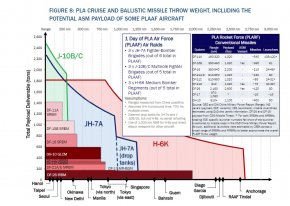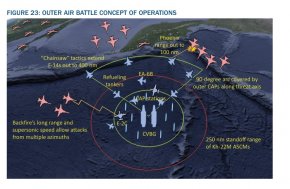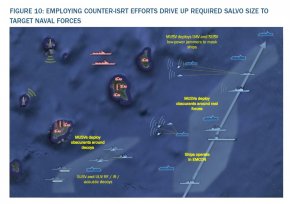I wouldn't be so sure about that. DF-21D, DF-26, DF-100, DF-17 and CH-AS-X-13 are all out there now, nevermind when the Hunters enter service.
Let me add to your discussion by sharing what I previously posted in the
China geo-strategic thread, last year — in DT, for years, we have been talking about protect (ASW or anti-air warfare) or prosecute (with submarines or anti-surface warfare with missiles like LRSM). No one is planning to take them head-on without allies.
The PLA(N)’s surface force of over 450 ships can carry a variety of anti-ship and anti-radiation missiles to force an Australian Naval Task group in the 2030s, to exercise emissions control, while striking from over the horizon, with one barrage of the DF series of missiles. Even the very capable JMSDF with their 4 huge escort fleets will struggle in the 2030s.
Are they? We are not planning for a war fought in the last 40 years, but for one that will be fought in the near future.
We won't be fighting the Battle of Jutland, nor Trafalgar, but a high tech battle which will involve supersonic and hypersonic AShM… and other nasties that aren’t in the public domain.
China’s land reclamation in the South China Sea is aimed at pushing its own sensor and weapons range so far into the Pacific (including the use of hypersonic missiles) that it becomes impossible for American forces to touch Chinese positions without risk to its fleet.
This is to gain freedom of action to assert its own interests against Taiwan. The only contingency PLA(N) can not manage as a 335-ship fleet, in 2020, would be a distant blockade by the US Navy. Capt (retd.) James Fanell has estimated that by 2030, the Chinese fleet will have a surface force of over 450 ships and a submarine force of about 110 boats. China could attempt to counter by increasing self-reliance or the careful establishment of a string of strategic positions in peacetime. Both are already core elements of current Chinese policy, namely “China 2049” and the “Belt and Road Initiative.”
Destroyers, frigates, carriers and bombers of the PLA(N)
1. Nanchang, the first Type 055 ship of the class, began construction in 2014 at the Jiangnan Shipyard in Shanghai, and was commissioned on 12 January 2020. There will be at least 6 of these 180 metre long, 13,000 ton destroyers/cruisers that are armed with 112 HHQ-9B surface-to- air missiles.
2. Kunming, the first 157 metre long, 7,500 ton Type 52D destroyer was commissioned on 21 Mar 2014 and is the first Chinese surface combatant to use canister-based universal VLS, as opposed to the concentric type VLS. 64 HHQ-9B surface-to- air missiles are carried, with 10 of this ship’s class being constructed (with 13 being planned according to the above graphic). Having entered military service on 12 Jan 2020, Zibo is the PLA Navy’s first ship of the improved version of the Type 052DL. This new Type 052DL is 161 metre long, with an extended flight deck (to carry the Z-20 helicopter) and a new long-range radar on its mast. The PLA(N) has plans for up to 13 Type 052Ds and 12 Type 52DLs in the near future.
3. Lanzhou and Haikou, the first two 155 metre long, 7,000 ton Type 52C destroyers were laid down at the Jiangnan Shipyard in Shanghai in 2002, and entered service in 2004 and 2005 respectively. The other 4 were of the class, Changchun, Zhengzhou, Jinan and Xi’an were built much later, around 2013, as the shipyard that built them was relocated.
4. Guangzhou and Wuhan, 155 metre long, 6,500 ton Type 052B destroyers were the first two Chinese-built warship capable of area air defence and entered service in 2002.
5. Binzhou, the first of 30 frigates of this class. These 4,053 ton Type 054A and 054A+ frigates are 134.1 metre long, armed with 32 HQ-16 or HQ-16B air defence missiles, was first built at the Guangzhou-based Huangpu Shipyard in 2005. An much improved variant beginning with the 17th unit has the seven-barrelled Type 730 CIWS replaced by the more capable 11-barrelled Type 1130, and is unofficially referred as Type 54A+. Another reported improvement over the original Type 054A includes the incorporation of a towed array sonar and present an overmatch against the capabilities of the Taiwanese Kang Ding class frigates. These 054A frigates are bigger and better armed than Singapore’s Formidable class frigates, who are the most heavily armed frigates that are based on the La Fayette design.
6. Ma'anshan, and Wenzhou, were the only Type 054 frigates built in 2003 and were commissioned in 2005. These outdated 134 metre long, 3,900 ton frigates were armed with the inferior HQ-7 (when compared to the HQ-16 and HQ-16B air defence missiles of the Type 054A). The Type 054 who are armed with the HQ-7 (similar to the French Crotale) resembled the French La Fayette-class frigates in shape and displacement and were intended to match the capabilities of the Taiwanese Kang Ding class frigates.
7. Right now in 2021, the PLA(N), operates 2 carriers, Liaoning (with 26 J15s) and Shandong (with 32 J15s) and a large fleet of Xian H-6 bombers armed with the YJ-12 anti-ship cruise missile (ASCM). The danger posed by the YJ-12 comes from its range of 400 km, making it the longest-ranged ACBM ever engineered, and its ability to travel at high rates of speed (up to Mach 3). These ASCMs when launched from the air, give the PLA(N) plenty of long range strike options. Just imagine how powerful the Chinese Navy will be by 2032, when it has 3 carriers and it begins to modernise its bomber fleet. Given its large H-6J and H-6G bomber fleet, the PLA(N) is more than its carriers — each of which carries 8 YJ-12 supersonic ASCMs.
8. A PLA(N), carrier battle group is heavily armed, with about 304 cells for air defence missiles. The destroyers serving as escorts also carry numerous vertically-launched
YJ-18 ASCMs, CJ-10 land attack cruise missiles, and the YJ-83 anti-ship missiles. The PLA(N)’s Yu-6 torpedo completed development in 2005 and is carried on their destroyers and frigates. At speeds of sixty-five knots, the Yu-6 is faster than the listed speeds of the Mk 48 Mod 6 ADCAP. The ships in a Chinese carrier battle group would typically consist of:
- 1 aircraft carrier (with 26 or 32 J15s)
- 1 Type 055, Renhai class cruiser with 112 air defence missiles
- 2 Type 052D or 052DL Luyang III class destroyers with 64 air defence missiles on each destroyer
- 2 Type 054A or 054A+ frigates, with 32 air defence missiles on each Jiangkai II frigate
- a Type 901 support ship



